#Pmmm meta
Explore tagged Tumblr posts
Text
It's actually really important to me that one of Sayaka's breaking points was her overhearing men being sexist and gross before absolutely losing it. Because it further emphasizes that Sayaka's main tragedy is not a boy not falling in love with her.
I think you can start applying this to Sayaka's character from when Mami first warns her to be cautious. What Mami tells her about think of why she's making her wish, I think it still applies, but not as her wanting Kyosuke to love her. I think Sayaka wanted to do good for others, but at the end of the day she wanted something out of that, primarily justice, change, a chance to make things better.
Her main tragedy is trying her absolute best to care for people, to be righteous, to use the powers given to her, to carve a better world; but to be given nothing in return. No reward, no foreseeable better future. Just suffering. And her eyes open to the suffering of others just for her to not be able to do anything about. Again and again and again.
And she tries to do this selflessly, like Mami indirectly told her to. To be fine with her efforts not being recognized, to be fine with people finding happiness without her, to be fine with people not respecting her right to make her own decisions. But at the end of the day that doesn't work and it tears her apart.
She wants to do something for the world, and risks her life to do it, the only thing she gets in return is her bodily autonomy being taken away. She's turned into a husk of a soldier without fully knowing what's going on. She's not even the best soldier (like her best friend could be), an average one. And she still tries to use that to keep fighting, because it has to be for a reason. It has to mean something. Because she's essentially given up everything, it has to mean something. It has to help her reach her goals in some way. Right?
It's not just a messed up way to cage her in a system that forces her to add onto the injustice she's fighting against. Right? Right?
(Maybe she calls herself stupid because she thinks she's stupid for trying to change things, for believing that things are capable of change)
#sayaka miki#puella magi madoka magica#Pmmm#pmmm sayaka#Madoka magica#Miki sayaka#Sayaka#Thinking of Sayaka (my beloved) because I'm drawing her#pmmm analysis#Pmmm meta#Rambles
129 notes
·
View notes
Text

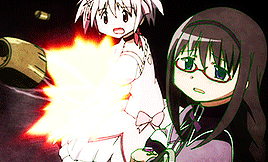

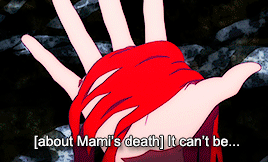


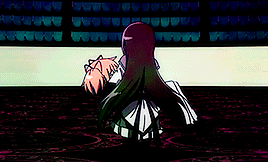
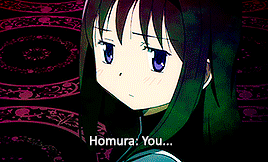
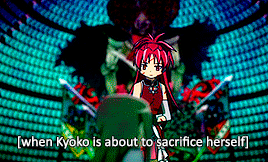
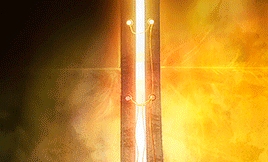
Homura + caring about the other magical girls
524 notes
·
View notes
Text

Smile!
In Magia Record's re-run of the Nagisa's Wish event, Yuu has at long last been given a canon design, and she's adorable.
In the past, I drew a design for her myself (here, and here) based on the old silhouette they used and I talked a bit then about the similarities I saw between her and Nagisa's appearances. Have a look at those for context if you'd like, because I'm going to revisit that again here with her new look. Below the cut ↓
To start with, some of the things I pointed out on Yuu's silhouette as being shared with Nagisa's magical girl outfit did not survive to her final appearance, such as the fuzz around the edge of her neck frill, the shorts she wears, and the bows along her tails and across her frill.
Though the tails themselves which I compared to the pompoms hanging from Nagisa's hat did survive, that alone isn't enough to draw a connection.

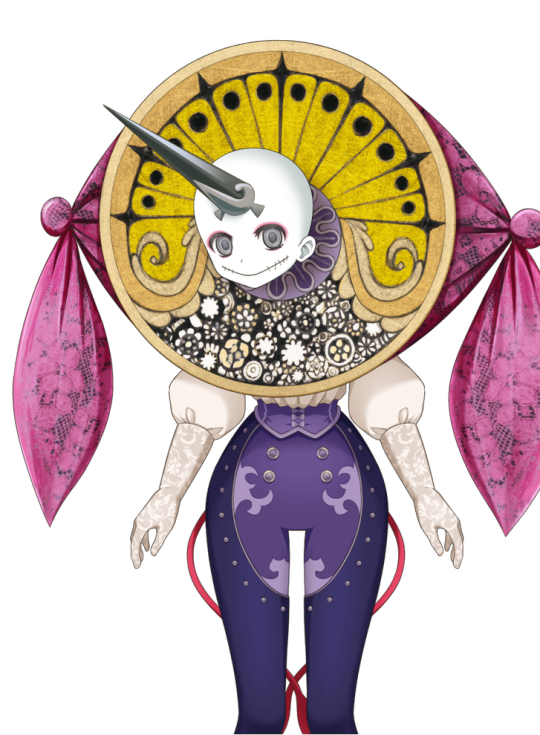
So it seems unlikely that when Nagisa made her wish, her appearance was influenced by Yuu being the first and only magical girl she'd met up to that point.
We can scrap that idea.
However, the parts of Yuu that I noted as resembling Nagisa's witch form, Charlotte... those do still hold up. When you look closely at Yuu, she has rings in her eyes which aren't present when she isn't transformed, and we now know that she uses her horn as her weapon.
Charlotte has a pure white face and a split open mouth, like Nagisa's mother described her killer. This is the strongest piece of evidence which the rest of it is built upon.
Charlotte attacks with her face as well.
And admittedly, perhaps reaching a little here, Charlotte as a worm has a cone-shaped pointy nose that might resemble Yuu's horn.
They also just both have clown energy.

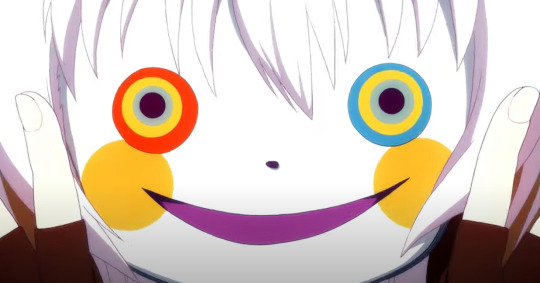
Huh. Looking at these pictures I'm now wondering if I could draw a comparison between Charlotte's head wings and the bundles of cloth hanging from either side of Yuu's head.
...
Yuu was instrumental in Nagisa's transformation over the course of the story, from someone accepting of the abuse she experienced every day into a person seeking to cut ties with her family and create her own freedom, and then Yuu played the part of the person who mistakenly took Nagisa's agency away from her at the end which is what tipped Nagisa over the edge, so I like the idea a lot that Nagisa's grief made manifest from that event took a form that recognises the significance of the Sleepwalking Ghost.

#pmmm#puella magi madoka magica#mahou shoujo madoka magika#magireco#magia record#yuu#yusa yumeno#yumeno yusa#yuusa yumeno#yumeno yuusa#nagisa momoe#momoe nagisa#pmmm meta#art#fan art#my art
380 notes
·
View notes
Text
Rorschach Inkblots in Rebellion

When Sayaka confronts Homura at the end of Rebellion, a series of abstract images--five in all--flash across the screen as Homura explains herself. These are reminiscent of the famous Rorschach inkblots, a series of drawings used as a projective test by twentieth-century psychologists. Given all of the other references in the film to German literature, philosophy, psychoanalysis--from Freud's "Fort/Da!" to Nietzche's "Gott ist Tot!" and Eternal Recurrence" to Goethe's "Eternal Feminine", and the entirety of E.T.A. Hoffmann's The Nutcracker and the Mouse King--it's not surprising that Rebellion would go here, as the Rorschach test was a popular method of measuring the unconscious mind in psychoanalysis and thus fits perfectly with the film's established themes.
However, when I looked a little closer, I noticed that the cards in the film don't match any of the original ten cards in the system (i.e., the ones most commonly associated with the test).
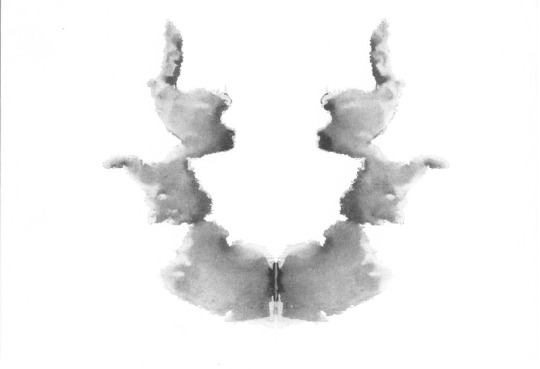

Card #7 (left) and Card #9 (right) of the main Rorschach series, from Wikipedia.
As you can see from the sample above, the original ten Rorschach cards are either all black and white or all colored, but not both, unlike the "hybrid" cards in Rebellion. Why is that? And what do they mean?

I did some more digging, and it turns out that although it's fallen out of fashion in the United States since its peak in the 1960s, the Rorschach test is extremely popular in Japan, where it's used for everything from personality analysis to marriage counseling. In addition to the modified Rorschach systems created by Western psychologists like Samuel Beck and Bruno Klopfer, there are a number of uniquely Japanese systems, including the Karo Inkblot test by Yasufumi Kataguchi, so it's possible that these images in Rebellion are part of one of these systems.
However, because the whole point of these inkblot tests is that the subject's reaction should be spontaneous, the cards in these systems are generally not released/revealed publicly, making it difficult to prove their origins way or the other. So what then?
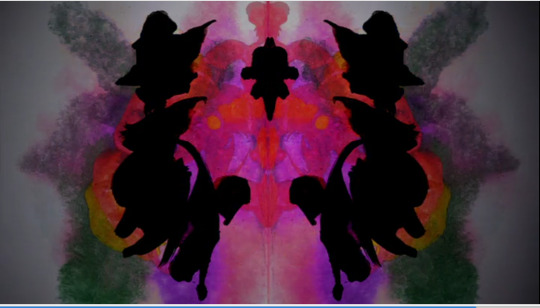
Ironically, that brings us right back around to projection! Since we the audience have no way of knowing what these images are supposed to mean, we have to construct the meaning out of these abstractions for ourselves, just like a real Rorschach test--which says as much about who we are and what we value as the image itself.
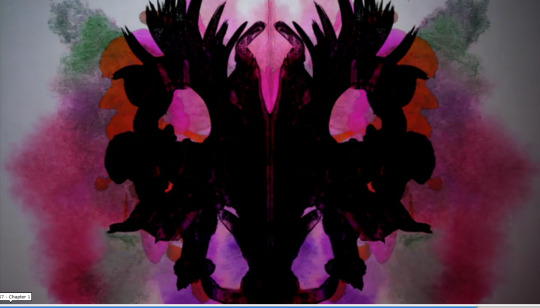
But let us not forget the greater context. As these images flash across the screen, they are accompanied by Homura's voiceover, declaring, (in the official English translation), "I am now an existence known as 'Evil'". Coupled with the abstract images, it suggests a certain level of moral ambiguity--is Homura truly evil or is this a role she has adopted in order to achieve her goals?

In a projective test, there are no right or wrong answers, only the limits of our imaginations and circumstances--paralleling the work of literary analysis and criticism. The genius of Rebellion is that, like the Rorschach test itself, the film provides no definitive answers to many of the questions that it raises, leaving the audience to decide how to interpret them--and even goes to the trouble of providing us these visual cues in order to emphasize the point.
54 notes
·
View notes
Text






I've always loved how ominously Kyubey is framed in these shots. The Mami scene is from episode 3 and the Sayaka scene is from episode 4, so we don't yet know the full extent of Kyubey's manipulation or even that he's a bad guy.
But there's something so sinister and predatory about the way that Kyubey appears when these girls are at their lowest point, at their most desperate. They'd do anything for a miracle, and Kyubey just so happens to provide those. Unlike the powerful and energetic awakenings portrayed in most magical girl shows, these just feel eerie and sad. You really get the sense that these girls had no other options, or felt like they didn't.
Not to mention these scenes do a great job of foreshadowing Kyubey's true nature.
#pmmm#madoka magica#puella magi madoka magica#my analysis#analysis#sayaka miki#mami tomoe#kyubey#meta
936 notes
·
View notes
Text
kinda long homura rant/analysis
“homura doesn’t care about anybody but madoka !!!!”
literally homura:
originally tried to save all of the girls before she eventually gave up bc it was literally impossible,
literally ran like hell to get sayaka’s soul gem back after madoka chucked it off the bridge and even closely inspected it w such care to make sure it wasn’t damaged at all,
admitted that she has hurt people (most likely the magica quartet, aka all of her friends, bc who else?) and feels immense guilt abt it and wishes she could erase it all (she literally says that hurting mami hurt HER),
can’t bare to kill mami (she looks so conflicted and sad when pointing the gun at her) and can’t even look at her when she shoots her in the leg bc she rly doesn’t want to hurt her,
subconsciously created a desired reality that she brought all of her friends (even kyosuke and hitomi, implying that she even cares for them as well) into where alive, happy, and together (ppl seem to forget that homura’s labyrinth was literally what she’s wanted deep down before it started to fall apart as she realized it was fake; sayaka literally points out how a witch who just wants to keep everyone happy and out of harm can’t be that bad, and kyuubey points out how homura would have most likely preferred to stay in this fake, happy world instead of realizing the horrible truth),
apologizes to kyoko for “getting her involved in this” after she realizes that she herself is the witch, aka most likely apologizing for wasting kyoko’s time when she asked her to go to kazamino city w her and for calling her,
rewrote reality in order to bring sayaka and bebe back to life and give everyone the happy life they always desired and deserved (she is literally willing to proclaim herself as “evil” and “the devil” and be unhappy if it means that madoka and everyone else gets to be happy and alive, safe from all the pain and the incubators who are still trying to prey on them and all magical girls)
… but she only cares abt madoka?
#💀💀💀#like c’mon guys…#it’s right in front of ur face…#we can’t be THAT media illiterate 😭#akemi homura#homura akemi#madoka magica#madoka magica homura#mahou shoujo madoka magica#pmmm homura#puella magi madoka magica#akemi homura rebellion#akuma homura#devil homura#homura akemi my beloved#mahou shoujo madoka magica rebellion#puella magi madoka magica rebellion#madoka magica rebellion#media literacy#common sense#media literacy is dying#media literacy is dead#character analysis#analysis#meta analysis#show analysis#media analysis#fandom critical#fandom critique#fandom criticism
454 notes
·
View notes
Text
i love how despite kyoko's death reflecting her father's, the nature behind it is completely different.
like they both died in the process of killing someone else but kyoko's father died with his actions being a sign of violence & corruption, while kyoko died with her actions being a sign of mercy & redemption


also fire imagery :3
#parent&child parallels save me.....#puella magi madoka magica#kyoko sakura#pmmm#character analysis#madoka magica#analysis#meta
357 notes
·
View notes
Text
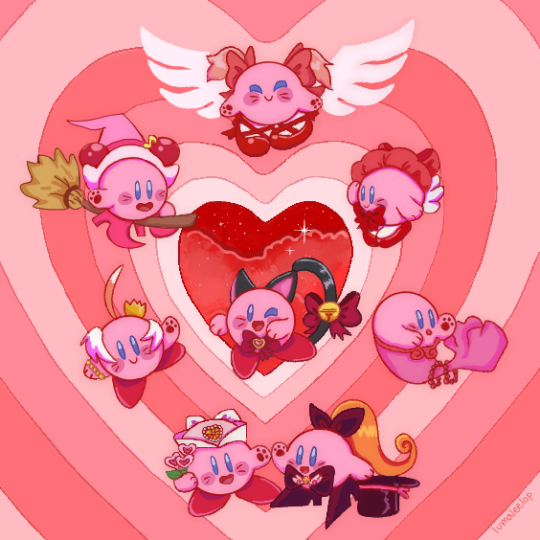
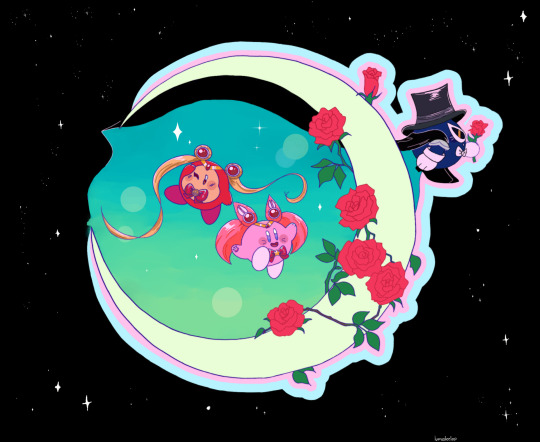
Kirby has all the qualifications to be a mahou shoujo protagonist!
#kirby#meta knight#sailor dee#sailor moon#pmmm#madoka magica#puella magi madoka magica#card captor sakura#tokyo mew mew#ojamajo doremi#princess tutu#mermaid melody#mermaid melody pichi pichi pitch#nurse angel ririka#nurse angel ririka sos#saint tail#mahou shoujos#magical girls#nintendo#nintendo fanart
772 notes
·
View notes
Text
Okay, the scene where Mami kills Kyouko is actually my single favorite scene in PMMM. I think about it all the time. I love it so much. Which sounds horrible, I know? But I think I love it because of its honest look at the characters in a desperate situation. And how in-character it is for all of them. It’s such a fantastic bit of storytelling from the writers.
Like Mami would absolutely be the first one of them to snap like that. She’s such an emotionally unstable character. Mami, more than any of them, wants to stop witches and save people because that’s how she makes peace with her lifestyle. So, learning that they’ll all turn into witches… of course she’s going to try and eliminate that possibility before it happens, even if it means killing her friends.
But even more so than Mami’s characterization in this scene, I love Madoka’s. I think it would be easy to assume that Homura would be the one to stop Mami, because Homura is seen as the colder character. So, I love that it’s Madoka. Madoka makes the quickest call she can in that moment to save Homura. Maybe they could’ve talked Mami down, and at that point, that would’ve been what Homura tried first. But Madoka couldn’t risk it and needed to react right away.
It shows us that in the main timeline, Homura is giving Madoka the time and space to make her decisions carefully/fully stop her because she knows that Madoka is impulsive when it come to her friends.
Basically it shows their characterization as this: Mami will always try and make the call that she believes will save the most people, Madoka will always try and make the call that saves her friends, and Homura will always try and make the call that saves Madoka. And that’s because for each of them, those are their salvations from the cruelty of being a magic girl.
#and also for homura lesbian reasons#ANYWAY#I feel like ppl may disagree w me but I’m not the sharpest tool sorry#this is more of word vomit than meta#it’s brainrot hours#from the drafts#pmmm#puella magi madoka magica#madoka kaname#homura akemi#kyouko sakura#mami tomoe#sayaka miki#holy quintet
87 notes
·
View notes
Text
Madoka Magica Ship Analysis - HomuMado
Based on these two polls [X] [X], I will write an analysis that'll also include how I feel about the ship (similarly to my Digimon shipping game analysis posts).

Disclaimer: I won't claim this to be a conclusive/definitive analysis of all of the ship's aspects. I have watched the original 12-episode-series and movies (including Rebellion), the Magia Record anime and I've read several manga series (the Original, The Different Story, Wraith Arc, Rebellion Story, Oriko Magica, Another Story, Mitakihara Anti-Materials). But I'm aware that I haven't seen/read all of what's out there and am also not thoroughly familiar with the games. Plus, oftentimes, ship dynamics vary depending on which series/timeline you are looking at. I'm fairly certain that thousands of words must have been written about this ship already, better and more elaborate than I probably ever could - so this is going to be my personal take on it.
Whether canon provides input on them or not.
As the main faces, characters (and ship) of the entire franchise, it's absolutely impossible to watch/read/play the series without taking note of Madoka Kaname, Homura Akemi and their dynamic. Their characters, arcs and development are irrevocably connected with one another - no pun intended (yet) - and without them, we wouldn't even have a story to talk about to begin with. But let's start at the beginning, shall we.
On one hand, we have Homura - who initially started off as a shy and timid girl, prone to sickness and ridden by insecurities. Presumably raised as an orphan at a government-funded orphanage, she struggles to find her way, fitting in at school, keeping up, making friends and socializing in general - thus she becomes an easy target for corruption (we shall keep this in mind for later) and is almost being dragged into suicidal tendencies by a Witch... If it wasn't for the pink-haired Magical Girl (and her senpai) who is going to rescue her - and Homura has no idea yet that she'll end up committing her entire life and purpose to her soon after.
Madoka initially starts off as not considering herself to be anything special - but is still determined to do good as a Magical Girl, she appears to be straight-forward yet kind, gentle and welcoming... Especially towards Homura. So - is it really surprising that Homura, timid, insecure, lonely Homura, would end up thoroughly enchanted by Madoka? The first real friend she must have had in ages? The person who smiled at her, reached out and encouraged her in her pure, innocent ways? Absolutely not, it's highly relatable, endearing... And thus, it shall be even less surprising to see Homura not wanting to lose her again. The feeling of being wanted, appreciated - of not being alone anymore.
After watching Madoka sacrificing herself, ending up killed by Walpurgisnacht in the original timeline, Homura makes her wish to become a Magical Girl herself - not just to meet Madoka again, but to be the one to rescue her this time. What appears to be a wish of determined, unexpectedly confident heroism at first will, just like every other wish, turn out to be a multi-layered mess of human complexity. An underlying desire born from affection - that will eventually turn into something deeper, desperation, obsession, whatever you may want to call it.
Homura lives through countless timelines, repeating the same month over and over again to save Madoka, discovering the fate of Magical Girls to become Witches eventually along the way, becoming more and more skilled at weaponry combat... At some point, she was already perfectly ready to become a witch alongside Madoka, as long as they're together, destroying the entire world - but is held back by Madoka's wish to prevent her from falling for Kyubey. And thus, Homura thoroughly hyperfocuses on her personal mission, so she won't lose the last bit of hope, no matter how bleak the situation may be. However, in the process, she is growing more and more distant, not only from Madoka and their fellow magical girls, but also from herself. Hardened by the experiences, she develops a cool facade and a stoic attitude, swallowing and locking away emotional attachment to anything and anyone that is not Madoka in order to reach her goal.
With every timeline resetted, more karmic energy revolves around Madoka - but with Homura's wish revolving around saving her, she also becomes increasingly more timid, reserved and insecure each time(line). While her general stance on Homura is still mainly the same - finding her, her look and name cute/pretty -, their ability to relate to one another dwindles with every reset. Homura's attempts at reaching Madoka, as desperate as they may appear, rather scare and alienate Madoka - who cannot possibly understand what she has been going through, the time she had spent, the absolute commitment...
Until Madoka eventually makes her own wish to honour all of Homura's achievements - until she wishes for witches to never have existed and, enabled by all the karmic energy, she becomes a literal Goddess in the process, the Law of Cycles to keep magical girls from despairing, creating an entirely new universe... One in which she has never existed as a human, but only as a concept. Selflessly wishing for everybody's happiness - whereas Homura wishes she didn't. While Madoka thanks her for all she had done for her sake, giving her her red hair ribbons as memory for safekeeping, Homura cannot fully accept this new reality. She does fight on at first, honouring Madoka's wish within a world that has Wraiths instead of Witches, determined to defy anyone and anything that shall threaten her legacy... But this state isn't meant to last.
The long twintail-braids shy, timid Homura used to wear alongside her glasses, mirroring Madoka's red-ribboned twintails as a symbol of innocence, are merely a memory of who Homura Akemi is going to become. For the sake of her initial wish, for the sake of devotion and love that have turned into an obsession that doesn't allow much deviation. And her will to keep living in Madoka's universe is fragile - as she has to overcome temptation in the shape of shape-shifting Wraiths, showing her her beloved Madoka once more - just for example.
And eventually, despair takes over: Trapped within a Witches barrier inside of Homura's own Soul Gem, a world has formed that technically would have granted her biggest wish - a world in which Madoka exists happily alongside her and her/their friends, fighting together, living a peaceful life... But this world is just a facade as well, meant to lure the Goddess into a trap to regain power over the old Witch System of an alternate reality. And Homura, whose hair can never be turned back into braids again, who has lost her way and purpose, turned into a Witch and is ready to sacrifice herself if it means keeping Madoka safe once more. But even as she is, once again, mercifully saved by Madoka in the end in return in another act of selflessness - Homura's initial wish takes over. To be the one to save Madoka - in Homura's sense, means to stop her from being selfless for once, giving her the chance to live a normal life in another fake reality. It's Homura's, presumably, selfish desire in contrast to Madoka's - as they have truly become opposites in every single way. In order to fulfill her wish and become Madoka's sanctuary - even against her will -, she became a Devil to defy the Goddess' universe, following a corrupted form of love once born from the wish to protect the one most important to her. To maintain the image of Madoka she had formed in her head, regardless of whether that is what Madoka has eventually become and wished for by herself. And thus, she cannot wear Madoka's red ribbon, the sign of her legacy and innocence, anymore. A black dress and red eyes now have to face a white dress and golden eyes. The braids cannot return... At least not for now.
... Too long, didn't read: There is A LOT to work with, you already know all of this and yet, I am pretty sure I haven't been able to capture every aspect of them.
Whether I think why and how they’d work.
As mentioned, depending on timeline, universe, state of progression, their dynamic tends to be WILDLY DIFFERENT. You can take Moemura/Shy!Homura and OG!Madoka, you can take Cool!Homura and Anime!Madoka (and their various states in between), you can take EndofAnime!Homura and Madokami, you can take Rebellion!Homura and Rebellion!Madoka, Homucifer and Madokami and you can take Homucifer and FakeWorld!Madoka... The possibilities are ENDLESS (especially when you also include the more comedic-leaning portrayals in spin-off mangas like Homura Tamura).
The good part about this is - you can basically pick your poison, you can make this dynamic as wholesome or as toxic as you desire your own personal brand of Yuri to be. Which is, in my opinion, one of the aspects that make Madoka Magica and HomuMado in general so unbelievably intriguing.
Let's start with the toxic side of things, because I would argue that this is where Rebellion left us hanging and where Walpurgisnacht Rising might continue (at first): Homura's wish and her mingling created a very idealized version of Madoka in her head that she wishes to protect and maintain. Her initial thankfulness and endearment towards the kind, strong Madoka in the original timeline have basically been replaced by her unshaken desire to SAVE her. She has to be the one who (selfishly?) stops her from being selfless, she has to be the one to shield and protect her from any harm, keeping her locked in a precious glass bowl preferably nobody else can mess with. The problem here is that this version of Homura (which is basically Homucifer, but also several stages of her before that) cannot accept any other reading of reality than her own. Yes, in an ideal world, she could have allowed Madokami to finally take her away to exist with her in lesbian heaven for the rest of eternity - but that was not what Homura had wished for. And also probably not what Homura thought she deserved after everything she had done. In a way, having her turn into Homucifer was also some kind of self-chosen punishment as a "sinner"...
And Madoka, honestly speaking, probably had a very idealized version of Homura in her head as well. I'm not just talking about Rebellion!Madoka (or FakeReality!Madoka for that matter), whose memories had been tampered with, but also Madokami - who claimed to have seen all that Homura had done for her, in all timelines and realities... But apparently, she hadn't noticed her state of mind, her being so close to despairing and snapping because she just couldn't take this universe. That she couldn't let Mami or Kyouko in, no matter how hard they tried. She still felt alienated from them and lonely, thus she always reverted back to her initial goal, as she simply didn't belong into this universe. It kinda leads me to believe that it may be impossible for even Madokami to see Homura as anything other than the braided girl from the very beginning, her "best friend" from the original timeline.
Long story short - these two need to actually TALK for once. Getting to know their REAL CURRENT selves in whatever state or timeline that may be. Seriously, letting Madokami and Homucifer have a verbal conversation about all these misconceptions and misunderstandings about each other, talking about needs and desires and BOUNDARIES in a meta-kinda-way would be incredibly satisfying to watch. (And I am pretty sure, such scenarios exist in both fanfiction and doujins, but I haven't found them yet!)
Personally, I also highly enjoy the dynamic between Moemura and OG!Madoka - even after a few timelines have passed, as it has been depicted in the second season of the Magia Record anime. It gave me the impression that Homura had already gained a little bit of confidence and Madoka was still hands-on enough for them to be on a similar wavelength - which makes their dynamic among the healthiest in the entire franchise and gives them a lot of opportunities to bond and develop. For Homura to form a proper sense of self, encouraged by but not entirely dependent on Madoka. Actually, this version is also incredibly close to the Rebellion dream versions of Homura and Madoka - which, unsurprisingly, also is one of the most peaceful versions of them, having them sit together in a flower field, talking for hours about actual things. However, this Homura is still hyperfocusing on Madoka here - and it may not even have been her 100% authentic self, since her memories had been influenced by Homura's vision of her.
However, you have to allow them to talk and actually get to know each other and their flaws, let them banter and tease... Let Homura see and learn to accept undesirable aspects of Madoka - and let Madoka shout back at her if necessary. Deep down inside, they both adore and admire each other - which is why they were compatible in the original timeline in the first place. Homura admired Madoka for her strength, whereas Madoka admired Homura for her coolness. And they absolutely have the potential to help the other to become their best selves. But they need to see each other for who they really are and thus have to abandon codependent tendencies for it to work; Homura has to accept that Madoka is her own person who doesn't need to be overprotected - and Madoka has to accept that she cannot "save" Homura just by herself, but that she may encourage her to get therapy to deal with her self-image first. Let Homura understand that "love" also means to let go. Let her see that different people define "love" differently as well and that you have to understand how your significant other loves to love them back right.
Whether I’d prefer them as platonic or romantic ship.
When I had watched Madoka Magica for the first time approximately 10 years ago, I was positively - and obviously - in love with this ship and its potential. I adored Rebellion for how tragically it portrayed it - and again, I'm not even sure if I did them justice in comparison to everyone who wrote about them before me. As outlined above, it has various layers to pay attention to and I absolutely cannot wait to see how Walpurgisnacht Rising will add to my initial analysis of them. Because their dynamic WILL change, there is no denying.
Even after all this time, I still (want to) see the romantic potential between them. They may not be my favourite Madoka Magica ship anymore, but I still rate them very highly due to their complexity, my own nostalgia and hopefulness - although I'm aware that I would ship them in very idealized ways myself that are self-indulgently peaceful (and required a lot of therapy). As much as I want to see them get a happy end one way or another - I am currently very invested in exploring Madoka's and Homura's polycule potential dynamics with the other members of the Holy Quintet and am looking forward to writing more ship analysis posts soon!
#madoka magica#puella magi madoka magica#pmmm#homumado#madohomu#homura akemi#madoka kaname#my two cents#meta#ship analysis#long post
42 notes
·
View notes
Text
reminder that homura is a middle schooler. she is 13 or 14 years old, depending on source. she is not old enough to drive or have a permit. she is not old enough to live on her own (it's implied her parents are out of the picture in some way — in the US she'd need to be in adoptive or foster care, or at least have a guardian or social worker, but this appears to be handwaved in the series and none are ever shown). she cannot vote. she is not old enough to get a job (earliest i've seen is 14 in the US, and that's usually in not great environments, in summer, and for low pay and short hours). she is only "independent" in the sense that it's forced upon her by lack of any adult support — nobody helps her fill out school transfer forms, she lives alone, she has no shown family or even mentions of relatives, nobody visits her in the hospital, etc.
i say this because a lot of "anti homura" arguments act as if this information doesn't exist, and that homura is "actually an adult" or at the same level as one due to looping. she canonically is not. her brain and physical body are not developing, she is only learning walpurgis tactics and memorizing test answers. her brain is not developing so she's not "mentally 26", like is often claimed by "homura is a predator" truthers. i'm not even going to touch on how weird and borderline creepy it is to say "she's a child but so mature for her age (from extreme, repeated, potentially pre-series trauma), so she must be an adult and can be treated like one".
there is a reason that children are typically tried differently in the US. unless "tried as an adult" for very serious crimes, it is widely accepted that children (and even young adults) are more impulsive, think less rationally, and are generally "less responsible" for their actions due to not having the experiences of a full grown adult. children are less mature, more prone to "overreaction" and panic, and are immature — because they are kids.
homura is a child. she also has extreme trauma, potentially from before the series even began (where are her parents? are they just neglectful? dead? why isn't there even a single adult helping her?) that is never helped or addressed. homura doesn't get help for any issues she has (obvious ptsd and depression, borderline delusions over the past being "just a dream" in wraith arc). she is not some spoiled, rich, mentally stable almost-adult who's never faced a consequence. she is a young and traumatized teenager, young enough to be a middle schooler, and has experienced:
neglectful, absent, missing, or dead family/parents
watching her friends die horrifically almost a hundred times
having zero adult support at all, no caseworker or help
bullying, half being because she's disabled
having her soul ripped from her body without consent and learning if she ever loses her soul gem (or god forbid accidentally drops it somewhere), her body will basically be "dead"
learning she and all her friends turn into eldritch horrors when they die, a process shown in rebellion to be something they are aware for (aka the horror that witches aren't "just" bodies being moved, they are actively and constantly suffering and aware to some degree the whole time)
learning that the witches they fight are girls around their age who fell into despair, and not purposeless monsters
learned of the prospect that witches can potentially "regrow" via familiars, thus if their consciousness transfers, this shows the possibility of literally eternal suffering as the witch is "reborn"
realization that, the more she tries to save madoka, the worse the situation gets
having a full on breakdown with delusions in wraith arc, thinking maybe madoka was all just a hallucination or a dream she had
finding out in rebellion it wasn't a dream, but then thinking she betrayed madoka by not stopping her from contracting
becoming a witch whose whole theme is based around suicide and wanting and waiting to die, but not being able to
being a witch whose familiars are malicious towards her and belittle her
trying to "fix" her believed betrayal of madoka by making a new world, ending up hated by sayaka and isolated from her friends
is still stuck as a witch while the last event happens!!! (her soul gem is never shown purified)
all of this while she is 13-14.
homura is not some cruel adult playing god because she is bored and likes the power trip and wants the world to burn. she is a deeply traumatized and mentally ill child who never got help. she is not a predator — and i honestly don't know if that is more of a "she's a predator because she's the most openly sapphic" or "she's a predator because she's traumatized and thus 'acts weird' due to trauma" belief nowadays in most anti-homura spaces, i've seen both. she is not a murderer or rapist or whatever else i've seen (yes, "homura is a sexual predator" claims exist, despite this never once even being implied). she is not an abuser — you can argue she's cold or rude, but she is not "an abuser".
if a child like homura existed irl (and they do exist), a professional's first thought would not be "this is an evil, irredeemable, abusive predator who can be treated like an adult", it'd likely be a reaction of horror and deep concern of "what happened to this child to make her act this way?". someone being "the perfect victim" — that is, being soft, demure, sweet, docile, flawless — in response to trauma is a harmful myth for a reason. some trauma victims will react with anger. some may be overly happy in an attempt to prevent further abuse. some, like homura, end up acting "cold" to try and avoid being further hurt. it doesn't mean homura doesn't experience emotion, hates her friends and wants them to suffer, is a predator, is "a bad person", etc.
think! when you write posts about how homura is actually an evil, awful, no good, very bad person with no positive traits, remember she is a middle schooler. of course, she's not a "real" child, and thus doesn't exist to have her feelings hurt over it, but consider this: would you say these things to/about a real child? are you aware that "real children" (often victims of trauma themselves) relate to homura due to this? i was one of them at 14ish, and while "homura is evil [for acting like a traumatized child often does]" discourse never left me particularly hurt, i know it does genuinely upset several people i know. and if you had, say, a real life child relative who acted "cold" after seeing their friends die horribly, would you call them an evil and irredeemable abuser as well?
#long post#pmmm#meta#madoka magica#homura akemi#nnnot my best work but 'homura not act like perfect victim of trauma? obviously EVIL PREDATOR ABUSER' takes take decades off my lifespan#abuse m#neglect m#tbh i only remembered the 'familiars can regrow witches' plotline while writing this and Realized. good fridge horror.#very long post#essays#ish
258 notes
·
View notes
Text
The loops, role reversals, and Walpurgisnacht: A PMMM meta
Madoka and Homura seem to consistently take on roles similar to each other. And because I haven’t been able to stop thinking about this, I’m going to write it all down. This stemmed primarily from NezumiVA’s video Understanding Madoka Magica- Part 2, especially where they pointed out that with each loop Madoka becomes more docile and the other magical girls tend to die earlier.
Timeline 1
At the beginning of the first timeline, Homura is relatively unconfident. When overwhelmed by others talking to her, Madoka steps in, and converse to what we see in episode 1, Madoka introduces herself as the nurses’ aid, asks to be called “Madoka” and asks if she can call Homura by her given name.
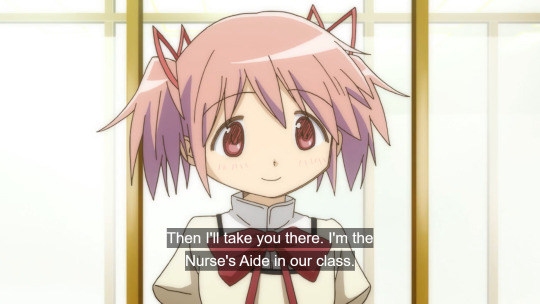
When Homura expresses hesitancy about her given name, Madoka says that it’s a cool name and Homura should become “cool” to match it. Immediately after this, we see a compilation of Homura performing relatively badly in both academics and athletics, both in front of an audience. While in both cases, others mention that she likely needs time to catch up, Homura seems to take this on herself. She also seems to have taken Madoka’s comment about becoming cool to heart, seeing herself as not being able to. Though most of this is likely amplified by the effect of the witch, Homura sees herself as being useless and a burden on others.
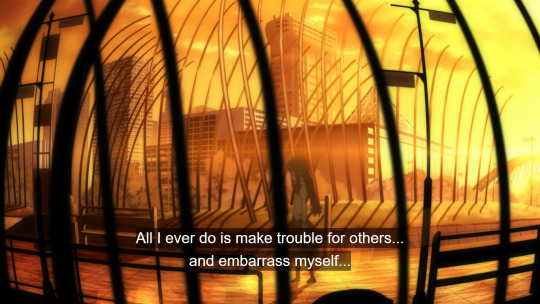
After Mami and Madoka save her and explain that they’re magical girls, we see Homura happy, visibly happy, opposed to earlier in the episode.
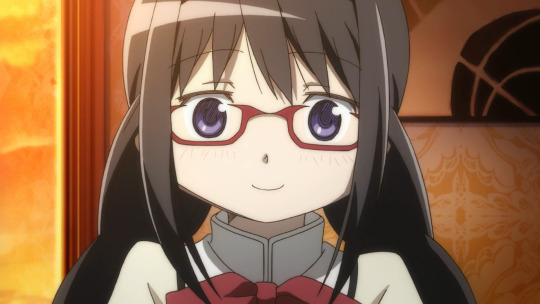
When Mami and Madoka fight Walpurgisnacht, Homura is the one to call attention to the fact that Mami just died, also here seemingly caring about death more directly than in other loops. As Madoka says that she is the only one left to defeat Walpurgisnacht, Homura pleads with her to run away, saying that no one would blame Madoka for doing so. Madoka persists, saying she is glad that she became a magical girl, eventually dying in the fight.
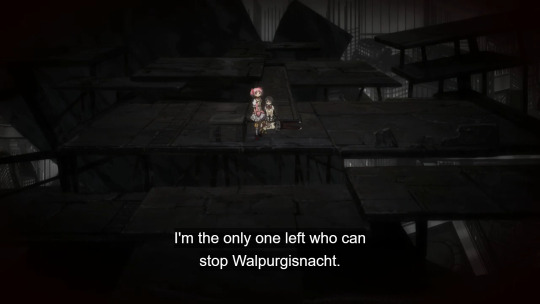
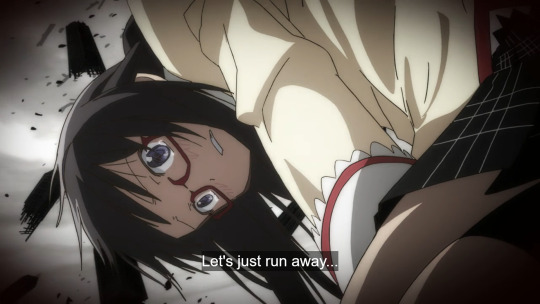
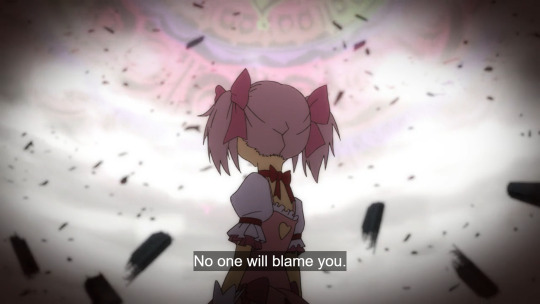
After Madoka dies, Homura is left with an immense amount of survivor’s guilt, placing emphasis on the fact that Madoka should not have died “Saving someone like her”. Bringing back ideas of her being a burden on others. Thus, as opposed to just saving Madoka, Homura wants to instead become someone who can protect Madoka, someone “cool” like Madoka wanted her to be. And most centrally, someone who would not be a burden, someone who others can rely on; someone who Madoka can rely on so she won’t need to fight alone.
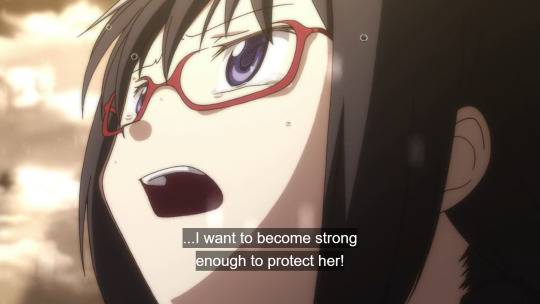
This wish traverses time and continues to rewrite it. Homura finds a moment of gaining control in a moment that seems hopeless, and decides to take responsibility for the new world she wants to create herself, regardless of how long realizing this wish may take.
Through the loops, Homura continues to do what she believes is necessary to protect Madoka: she trains, she becomes less docile, she becomes more hostile to the other magical girls (especially Mami and Sayaka who more directly influence Madoka’s involvement as a magical girl). She becomes colder, and she physically loses aspects of herself (her braids, her glasses) that might stereotypically be associated with weakness, or her old self. Then we arrive at the present loop.
The series loop, loop n.
In the nth loop, Homura begins with taken on the initiative of reaching out to Madoka, who in this timeline is visibly more timid. She also seems to speak with less conviction than she used to in timeline 1. She seems hesitant to approach Homura as she previously had. Homura introduces herself, and initiates Madoka and herself referring to each other with their given names. Homura is notably leading the way this time.

Homura here has restarted their first meeting, however she seems to have taken on a role similar to Madoka back then. Here she issues Madoka her warning, telling her that she does not need to change, ironic considering that Homura’s timeline resetting seems to have affected Madoka’s personality the most.

Just like Homura in loop 1, we find here that Madoka does not see herself as anything special, the idea of becoming a magical girl in itself gives her a sense of joy and a sense of purpose. This is cast aside with Mami’s death. However, Madoka does try to help out in whatever way she can. The feelings of being a burden reach a hight for Madoka when Sayaka (at this point almost a witch), brings up how unhelpful she is despite having an enormous amount of potential (this likely coming from Sayaka’s frustration in not having the same abilities despite putting her all into her fights).
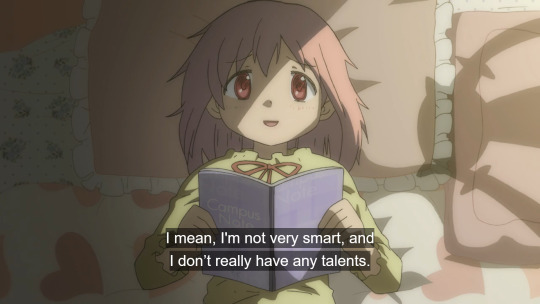

In this timeline, Homura has decided to, like Madoka in timeline 1, take Walpurgisnacht alone. But Madoka decided that she will not let her. With each timeline, Madoka becomes a magical girl later and later, this potentially being the latest in the timeline Madoka has become one. Madoka here decides on a wish to rewrite time, like Homura, and be directly involved, taking a position of control and executing her wish herself. She is also willing to take on this role for however long it might be necessary, similar to what Homura continues to do.
It is interesting to note that in every timeline despite what Homura does, Madoka in the end, due to the cosmic energy now tied with her, ends up becoming more powerful than her, and ultimately due to differences in how involved they want to be with the world, Homura is consistently unable to “save” her from her “fate”. Even when Madoka takes on Homura’s timeline 1 role, Homura is consistently unable to escape from her own role at the end of timeline 1; being helpless.
At this point Homura cannot restart as she usually would, and even if she was able to Madoka has become so powerful that Homura cannot be the one protecting her.
Rebellion
As a witch, Homura here is essentially causing herself misery and despair, perhaps partially due to the incubators containing her, or perhaps due to her self-loathing being so great that she first enacts it on herself.
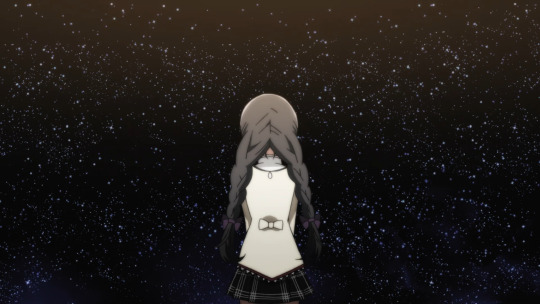
The labyrinth she traps herself in is ideal where she and the others are safe. Interestingly, Homura here is Homura similar to herself in loop 1. As time passes, even with Homura figuring out the true nature of the world, she is essentially unable to do much able it, taking back her role from loop 1. Before her witch form takes root, there’s a scene with Madoka literally braiding her hair, putting her back into the mindset of this role. We see her consistently fail to save Madoka, consistently being helpless, consistently not being strong enough. Emphasized further by the Nutcracker imagery (Homulilly’s imagery is similar to the Nutcracker in the story of its’ namesake after it’s jaw has been cracker, rendering it useless. Pointed out by NezumiVA (Understanding Madoka Magica- Part 2)).
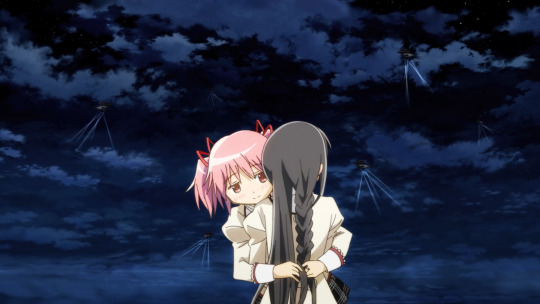
Rebellion changes things however, as here Homura learns that Madoka does not like her fate at the end of the series (interestingly, Madoka never said she was okay with in in the finale as far as I could find, she mostly just assures Homura that she technically won’t be alone). Homura at this point has tried to fight fate countless times, and each time, despite what she does, Madoka does get involved. Her braid unravels, things are moving away from their usual loop. At this point she realizes that she needs to protect Madoka from herself. She has to fight Madoka.
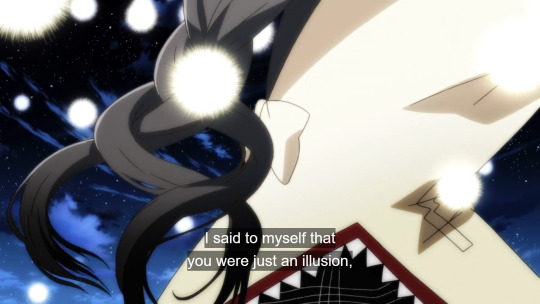
She pulls Madoka away from the circle, again taking on a role of control and resetting the world to create something that she desires (similar to the end of loop 1). However this time, similar to Madoka at the end of loop n, Homura herself moves outside of the loop, gaining power (likely connecting enough cosmic power to herself via the loops, largely unintentionally, to do so), and considering that Madoka here is now to be not in her God form, Homura finally has more power than her (and even in case of Madoka regaining her powers, she at least has a chance of having equal powers).
Loop n+1
When we reset this time, Madoka and Homura more literally switch roles from loop 1, with Madoka being the transfer student and Homura guiding her. Homura gives back Madoka’s ribbon, perhaps signifying that she will not be taking Madoka’s role in loop 1. Homura has decided that she will do everything necessary to keep Madoka safe, even if that means fighting her. Somewhat unwittingly, Homura also seems to have taken a little more of Madoka’s sacrificial nature here, seeming to have less self-preservation her than in the past, though this could also be due to the influence of her witch state.
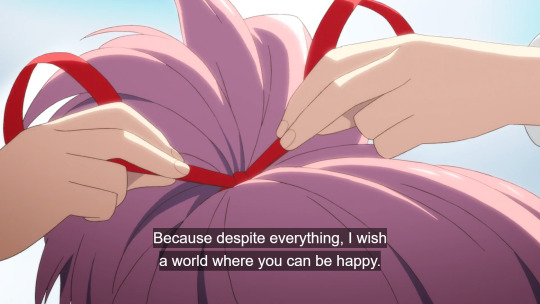
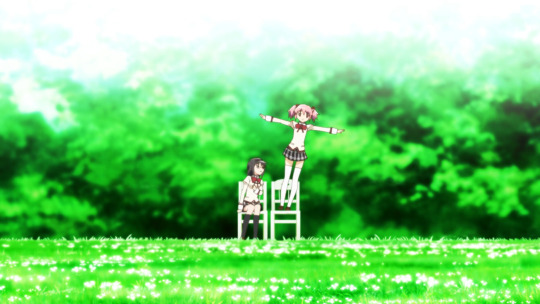
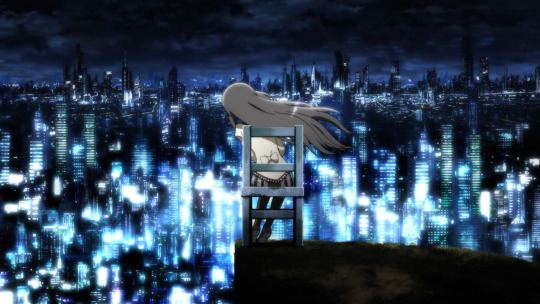
Walpurgisnacht
Seeing that in the finale we see Madoka save magical girls before they become witches, I find it interesting that we do not see this for Walpurgisnacht.
From the wiki:
“Its nature is helplessness. It symbolizes the fool who continuously spins in circles. The Witch's mysteries have been handed down through the course of history; its appellation is "Walpurgisnacht." It will continue to rotate aimlessly throughout the world until It completely changes the whole of this age into a drama.”
As many others have pointed out, the chairs that appear randomly, for example in Madoka’s room, and the curtains that at points seem to resemble a stage with curtains and a seated audience.
At the beginning of Rebellion, as @atamascolily has pointed out here, there are several elements that go around in circles. Knowing what we know now about this being Homura’s world, and her time loops, essentially causing her and Madoka to circle and loop around one another, both literally and in terms of roles, and Homura’s primary fear being too helpless to have influence and help Madoka, I think at some point Homura or Homulilly becomes Walpurgisnacht, or the primary witch that triggers the creating of the merge of witches that we now know as Walpurgisnacht. As pointed out by @sayaberry, here, in the trailer for Walpurgisnacht Rising, Homura’s dress becomes similar to Walpurgisnacht’s. The loops also are consistently linked to Walpurgisnacht’s appearance, so she ends up keeping the cycle going. Additionally, it might be that the way that Homura might move away from the helplessness of not being in control, might be in taking total control via creating, essentially the ultimate show.
Also, interestingly, Walpurgisnacht and Madoka’s witch form, Kriemhild Gretchen are said to form two halves of an hourglass; together needing to literally switch places in order to reset time.
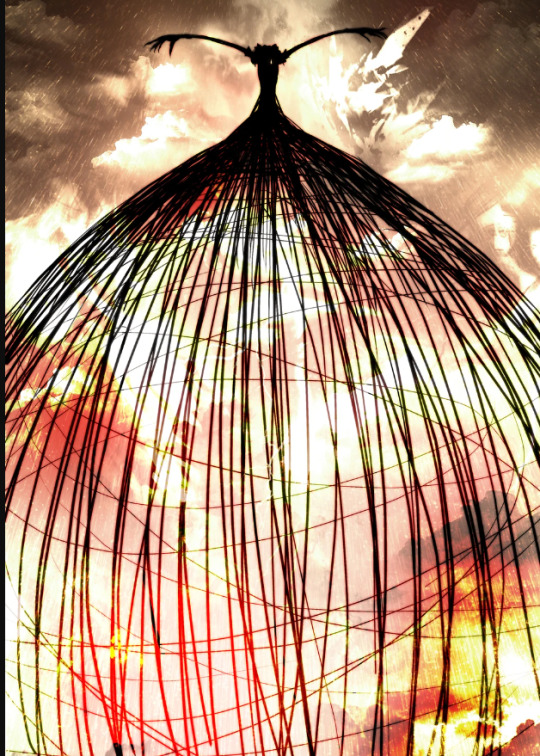
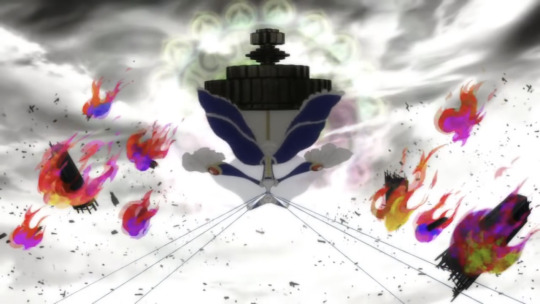
#puella magi madoka magica#Madoka Magica#PMMM#Madoka Kaname#Homura Akemi#Madoka Magica Meta#Pmmm meta#Akemi Homura#Kaname Madoka
83 notes
·
View notes
Text
GUYS where is the kyosaya 'good luck babe' animatic.
sayaka in love with kyousuke and devastated that she can't be 'normal' for him because she's a dead girl walking. kyoko seeing that this impossible "love" is only devastating for sayaka because it represents her inability to reach that selfless 'ideal' girl image she has of herself, chasing shadows on the wall
kyoko, a fellow dead girl, a dead idealist, seeing that noise for what it is, only for her screams to fall on deaf ears. "you'd have to stop the world just to stop the feeling" kyoko holding sayaka's grief seed in her hands "i hate to say it, but I told you so"
god where is it?
#kyosaya#kyoko sakura#compulsory heterosexuality#heteronormativity#sayaka miki#pmmm#puella magi madoka magica#madoka magica#metas#sapphic#comphet
63 notes
·
View notes
Text
after 2 weeks of being sleep deprived and drowning in procrastinated schoolwork, and after 2 sleepless night physically fist-fighting youtube who kept giving me random copyright flags my second video essay is finally up 😭🙌🏻
in it, i discuss how two of goethe’s most influential works, “the sorrows of young werther” and “faust”, have influenced the themes and narrative in madoka magica. in the essay, i use this analysis to speculate what might happen in the fourth movie. at the very end, there’s an unscripted rant that i recorded after the second pv came out and i lost my mind lol
HOPE YOU ENJOY! i’ll now be sleeping for the foreseeable future 🫡
#it’s again almost past 3:30am 😩#OH and the video is once again not available in germany and austria. why are y’all gatekeeping pmmm so hard im so mad#idk what to tag my eyes are clinsg#madoka magica#pmmm#goethe#faust#homura akemi#akemi homura#kaname madoka#madohomu#meta analysis#my video essay#mine
30 notes
·
View notes
Text
Thinking about how Kyubey is as tragic as every other Madoka character, the fandom just doesn't talk about it because Fuck Him.
I genuinely think that, if Kyubey had been upfront with humanity about what he wanted from the start, the magical girl system could have been way less of a thing, perhaps completely unnecessary.
With how much power he actually has, fixing the energy problem within a couple of wishes wouldn't be easy, but it would be doable.
Incubators work much differently than humanity, and don't get the concept of true cooperation.
Kyubey is just as trapped in the magical girl cycle as the rest of them, and he's completely unable to see it.
The universe will meet an inevitable and pointless death because, like Homura, Kyubey runs the same plan over and over with minimal changes.
30 notes
·
View notes
Note
in PMMM, is it ever explained why magical girls can't just not use magic, therefore sparing their soul gems from being corrupted? that seems like the easiest course of action to me, but there must be a reason why they don't do it.
I don't think it's ever explained in the main series, but I think supplementary material does touch on it. Basically, magical girls will absolutely need to get Grief Seeds at some point because, even when not actively using magic, they passively use magic every day to sustain their bodies.
Remember, magical girls are liches. Their bodies are dead and are no more than puppets used by the true soul/consciousness stored in the Soul Gem (this is in contrast to regular humans, whose bodies and souls are fundamentally intertwined). Sustaining the physical body and keeping its heart beating requires magical intervention (even though most magical girls aren't aware of it).
I like to think about it in terms of calories. Even if you do literally nothing all day except lay in bed, your body still burns a lot of calories to sustain itself. This is why eating regularly is important. In the same way, magical girls passively burn magic to sustain their bodies, so at some point they will need to use a Grief Seed even if they never actively use magic.
Oh, one last thing- it's shown that some magical girls passively burn magic at higher rates than others. Oriko Mikuni (the titular character in the Oriko Magica spinoffs) burns a lot of magic via her precognition ability. Because Oriko initially can't control when and how often she gets visions of the future, she burns a lot of magic even though she's never actively used magic. She later gets better about this and doesn't need to purify her Soul Gem as often.
#asks#Anonymous#pmmm#madoka magica#puella magi madoka magica#oriko magica#oriko mikuni#meta commentary#meta#analysis#my analysis
204 notes
·
View notes